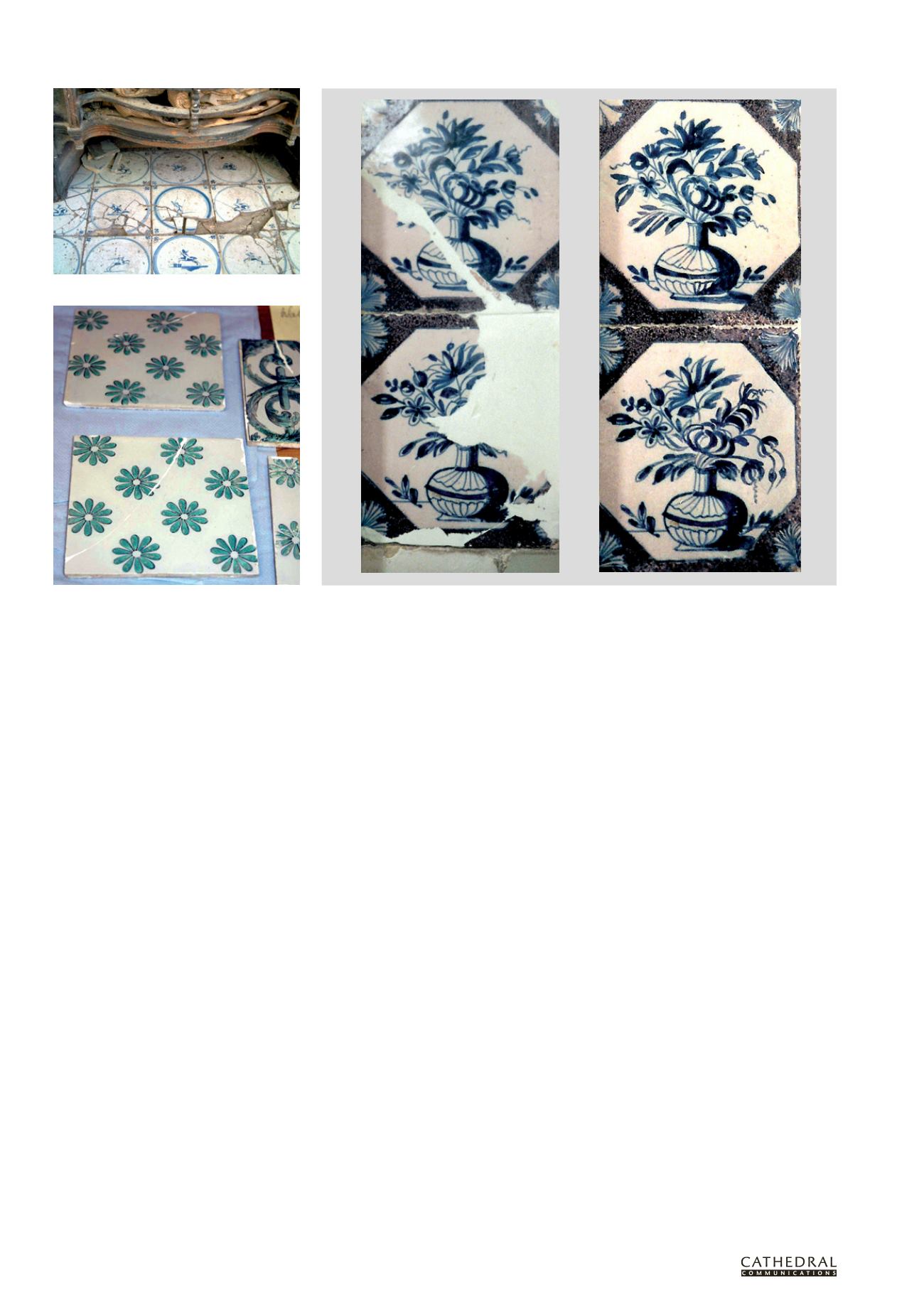

1 7 8
T H E B U I L D I N G C O N S E R VAT I O N D I R E C T O R Y 2 0 1 5
T W E N T Y S E C O N D E D I T I O N
INTER IORS
5
Fractured hearth tiles with worn glaze surface
Fractured Sadler and Green printed tile, glued and
filled with plaster of Paris
Composite image showing tiles before and after painting restoration
Mortar degradation
Thermal shock and water penetration are
common causes of degradation. The mortar
will first expand and then shrink on cooling
or drying at a different rate to the tile, causing
cracked mortar or complete detachment. Even
if the mortar has failed, however, the tiles may
remain in place, held together by the grout.
Failed mortar is detected by a hollow or rattling
sound or bulging surface plane and loose
tiles. Lime plaster adhesives are extremely
corruptible and easily subject to degradation.
Corroded ironwork may also cause
fracturing due to expansion of the ironwork.
While problematic in itself, structural
movement rarely has an impact on 18th-
century tile work unless, of course, movement
causes tiles to become unseated and fall. Lime
plaster adhesive will fracture and shift without
damaging tiles because it is inherently weaker.
Mortar consolidation
Consolidation can be achieved by introducing
an adhesive liquid by capillary action which
will creep into voids and give additional
adhesion between tiles and mortar. The
advantage of this method is that both the
tiles and the original mortar are left largely
undisturbed except for the intrusion of the
adhesive liquid. The disadvantage is the near
impossibility of complete re-adhesion as there
will always be some areas which the liquid will
not reach.
Compatibility of materials and
reversibility are important considerations
when choosing a consolidant. It must not
be stronger or harder than the ceramic tile
and because Delft tiles have relatively weak
bodies, only a few consolidating materials
are suitable.
Re-fixing tiles
There are various methods for re-fixing
18th-century Delft tiles. The substrate behind
the adhesive layer must be relatively weak or
sacrificial. This will protect the tiles into the
future. In a new location this can be a layer of
plaster board on a stud frame. In a traditional
location the substrate must be lime mortar.
Lime used as a tile adhesive must be
naturally hydraulic. The inclusion of plaster
of Paris with a hydraulic lime produces a
‘selenitic’ lime, which gives very good grab but
is not suitable for damp conditions.
Repairing 18th-century tiles
Paraloid b72 is a standard consolidant
adhesive for Delft tiles and other soft-
bodied ceramics. It can be applied, diluted
in acetone, with a fine paintbrush around
the fragile edges of distressed glaze
and over vulnerable crazed areas.
Restoration also works well as a form of
conservation – filling missing areas of glaze
or body clay is preferable to leaving damaged
edges and surfaces uncovered and therefore
unprotected. The original material of the tile
will be better preserved if there is a sound
surface area. The introduction of a white
plaster of Paris infill where fragments are
missing in a scheme will not greatly detract
from the overall visual aesthetic (above left).
If the intention is to restore the colour
and decoration to fragmented and missing
areas of tiles then it is advisable to use an
acrylic- and calcium carbonate-based fine
surface filler as it will provide a smooth
dense surface finish for paint application.
The decoration can then be applied using an
acrylic clear glaze mixed with artists’ powder
pigments to match (above right).
MAINTENANCE
Good maintenance relies on positive action to
maintain an ambient environment suitable for
soft-bodied tin-glazed tiles. Damp conditions
with excessive moisture ingress into the
mortar or substrate are the most common
cause of damage.
Recommended Reading
L Durbin,
Architectural Tiles: Conservation
and Restoration
, 2nd edition, Routledge,
London, 2014
English Heritage,
Practical Building
Conservation: Earth, Brick and Terracotta
,
Ashgate, Farnham, 2014
Expert guidance on the care and conservation
of historic tiles can be found on the
Jackfield Conservation Studio website
www.jackfieldconservation.co.ukLESLEY DURBIN
ACR began working
in conservation in 1983 and is senior
conservator in The Jackfield Conservation
Studio, based at Jackfield Tile Museum,
Ironbridge. She has worked in the
conservation of architectural tiles
for over 30 years and is the author of
Architectural Tiles: Conservation and
Restoration
(see Recommended Reading).
















